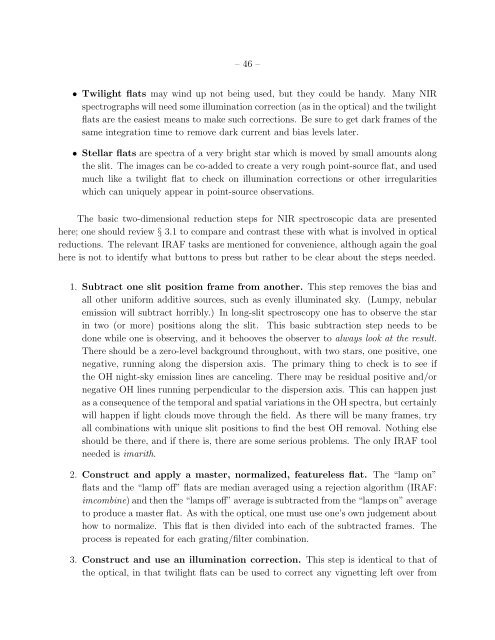Astronomical Spectroscopy - Physics - University of Cincinnati
Astronomical Spectroscopy - Physics - University of Cincinnati
Astronomical Spectroscopy - Physics - University of Cincinnati
Create successful ePaper yourself
Turn your PDF publications into a flip-book with our unique Google optimized e-Paper software.
– 46 –<br />
• Twilight flats may wind up not being used, but they could be handy. Many NIR<br />
spectrographs will need some illumination correction (as in the optical) and the twilight<br />
flats are the easiest means to make such corrections. Be sure to get dark frames <strong>of</strong> the<br />
same integration time to remove dark current and bias levels later.<br />
• Stellar flats are spectra <strong>of</strong> a very bright star which is moved by small amounts along<br />
the slit. The images can be co-added to create a very rough point-source flat, and used<br />
much like a twilight flat to check on illumination corrections or other irregularities<br />
which can uniquely appear in point-source observations.<br />
The basic two-dimensional reduction steps for NIR spectroscopic data are presented<br />
here; one should review § 3.1 to compare and contrast these with what is involved in optical<br />
reductions. The relevant IRAF tasks are mentioned for convenience, although again the goal<br />
here is not to identify what buttons to press but rather to be clear about the steps needed.<br />
1. Subtract one slit position frame from another. This step removes the bias and<br />
all other uniform additive sources, such as evenly illuminated sky. (Lumpy, nebular<br />
emission will subtract horribly.) In long-slit spectroscopy one has to observe the star<br />
in two (or more) positions along the slit. This basic subtraction step needs to be<br />
done while one is observing, and it behooves the observer to always look at the result.<br />
There should be a zero-level background throughout, with two stars, one positive, one<br />
negative, running along the dispersion axis. The primary thing to check is to see if<br />
the OH night-sky emission lines are canceling. There may be residual positive and/or<br />
negative OH lines running perpendicular to the dispersion axis. This can happen just<br />
as a consequence <strong>of</strong> the temporal and spatial variations in the OH spectra, but certainly<br />
will happen if light clouds move through the field. As there will be many frames, try<br />
all combinations with unique slit positions to find the best OH removal. Nothing else<br />
should be there, and if there is, there are some serious problems. The only IRAF tool<br />
needed is imarith.<br />
2. Construct and apply a master, normalized, featureless flat. The “lamp on”<br />
flats and the “lamp <strong>of</strong>f” flats are median averaged using a rejection algorithm (IRAF:<br />
imcombine) and then the “lamps <strong>of</strong>f” average is subtracted from the “lamps on” average<br />
to produce a master flat. As with the optical, one must use one’s own judgement about<br />
how to normalize. This flat is then divided into each <strong>of</strong> the subtracted frames. The<br />
process is repeated for each grating/filter combination.<br />
3. Construct and use an illumination correction. This step is identical to that <strong>of</strong><br />
the optical, in that twilight flats can be used to correct any vignetting left over from

















